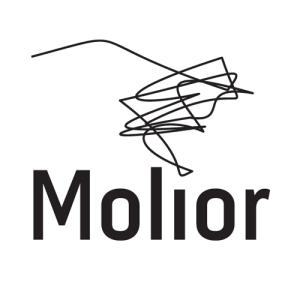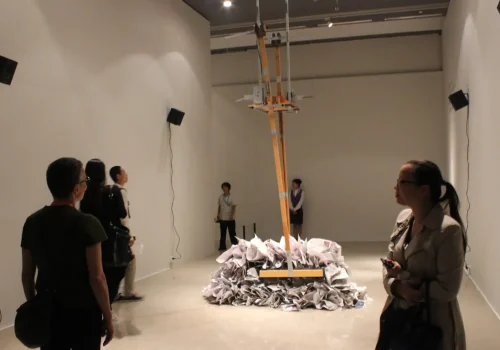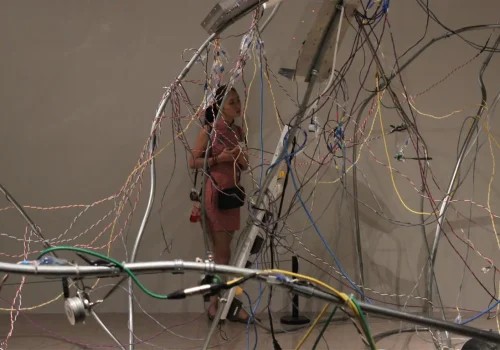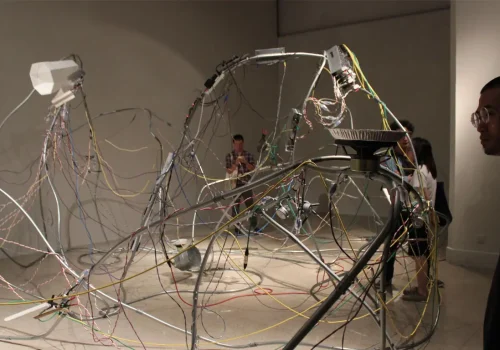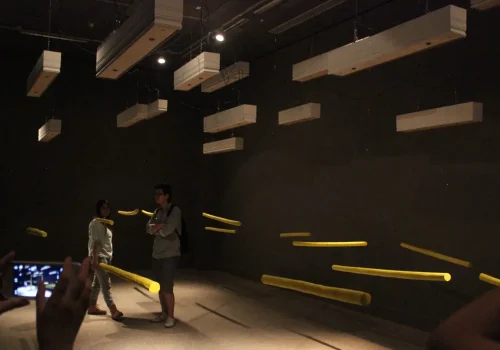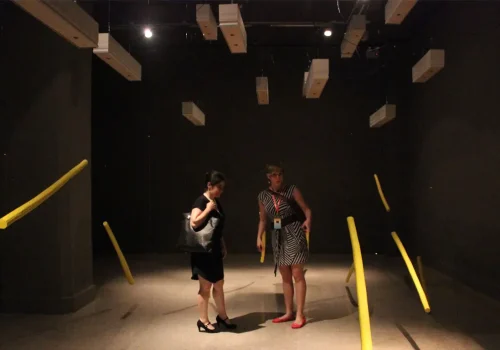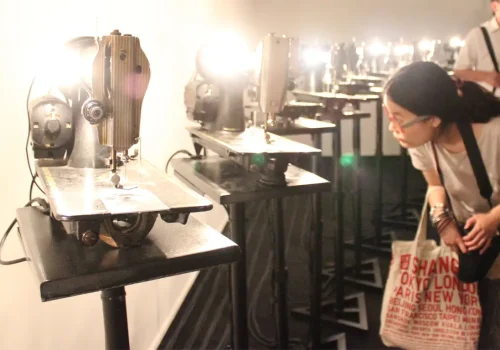thingWORLD_International Triennial of New Media Art
Beijing, China
From June 10th to July 7th, 2014
Curator
Zhang Ga
The world is a thingworld.
For without things there would be nothing to describe, to interpret, to comment on, there would be no evocative signifiers that trigger imagination, conjure up representation, neither would there be societies nor cultures. The world is a thingworld. In Chinese language, the word for “thing” is a compound of the characters East and West, a geographic stretch across the infinite space of two imaginary ends in the ancient mind. Thing is everything.
For a long time, this salience of thing has been sequestered in order to foreground the primacy of man. Thing has unequivocally become a mise en scene as that which services the drama of humanity. The plight of thing certainly is a construction of modernity, as a product of the Enlightenment which constituted a new order of things predicated on the subjectum with man as the center and measure of all beings (Heidegger), “ding an sich” (Kant) therefore is a logical fallacy for how else can thing be of any purpose except for that of man? A thing being can only make sense for a human being and has always remained visibly absent, as Heidegger has amply discussed its readiness–to-hand and its subjugated substance until its mishap of presence-at-hand of malfunction, of being kaput reveals the substrate of thing.
Thinking thing as thing unto itself (ding an sich) is a precarious proposition, one that agitates the promise of the Enlightenment and of the human subject rendered through the a priori that destines the legitimacy of political constructs and cultural production of the modern world. Although the capital on that account has been long overdrawn by the dissipation of the grand narrative in the wake of the horror of inhumanity, through the postmodern demystification of subjectivity in the wake of gender, racial and sexual struggles and the pluralism purchase of the contemporary, but the dispute has never left the “I and You”, the subjects that immanently assumed power of discourse, the subjectum. The prosecution and verdict have never left the courtroom of the human habitat.
Another logic that is skeptical of the Enlightenment axiom, a speculative argument by character is emerging as an antidote for setting the score correct, one that circumvents the vicious cycle of the debate of humanism to extend the subject world to the world of object, the thingworld is on the horizon. To rehabilitate the lost status of things, to make heard the reticence of things, to restore to its proper place in the human world a thing world, has political consequences and cultural implications. In aligning the animate and the inanimate, organic and inorganic, human and nonhuman, a democratic multiplicity may rupture the stasis fraught of the vehement bickering between idealism and realism in the exegesis of equity. The re-initiation of the thingworld proclaims a radical ontology of equality. Equality of Everything thus forecloses the interminable contention of subject and object, of the “I and Other” and the repressive corollary therefrom; Equality of Everything suspends the irreconcilable cultural feud waged in the battle of representation and identity whose frivolity is made ever more pronounced in the face of irrevocable global warming and ecological predicament that the hubris of the human world is accounted for.
In this re-illuminating endeavor, there has brought into light a hitherto undisclosed reality: the technical reality, of which it is a transduction reciprocally constituted of humanity and technicity, and via this imperative recognition, we begin to appreciate a new world order composed of physical being, technical being and human being (Simondon) of equal bearing. Technology here reinstates itself a liberating potential as thing itself as well as a mediating negotiator between the human world and the thing world.
This exhibition shows such promising comingling of a world of actants, as Latour would suggest, of all kinds, animated, alive, present. Technology (as the reciprocal transduction of humanity and technicity) with its initiating modality may be the surprise candidate to turn anthropocentrism on its head: physical being via technical being achieve their own vivid presences, their own agency and autopoiesis, their own generativity, thereby evoking a conative viscerality for the human being. They act and interact, dialogue and monologue, or chorus in the assemblage of the thingworld. In celebration of thingworld, there emerges opportunity to reinvigorate the impasse of cultural production that is contingent solely on the premise of human subject with a much-expanded field of operation; there will be a newly found world of discussions, concerns to give rise to new forms of artistic experimentation and a new vocabulary of aesthetic manifestation. Part I Monologue – Ding an Sich Part II Dialogue – Ding to Thing Part III Ensemble – Parliament of Things
[Zhang Ga, curator]
Zhang Ga
Zhang Ga is a media art curator, professor of Media Art at Academy of Arts and Design, Tsinghua University (Beijing), and associate professor of Media Design at the School of Art, Media and Technology at Parsons The New School for Design (New York).
He also holds appointments as Consulting Curator of Media Art at the National Art Museum of China, Senior Researcher at the Media x Design Lab of EPFL | Swiss Federal Institute of Technology Lausanne and Visiting Scientist at the MIT Media Lab in the U.S. He was Artistic Director / Curator of Synthetic Times: International New Media Art Exhibition, a Beijing Olympics Cultural Project organized by the National Art Museum of China in 2008 (catalogue by the MIT Press), among numerous other curatorial projects.
He has been on many jury and consultation committees including the (former) World Trade Center Artist Residency Program, Rockefeller New Media Fellowship National Nomination Committee, Prix Ars Electronica among others. He organized and curated the First, Second and Third Beijing International New Media Art Exhibitions and Symposiums, extending the global new media art discourse into mainland China. He has lectured widely around the world; most recently he was a keynote speaker at Re:Live09, Third International Conference on the Histories of Media Art, Science and Technology.
In 2010, he founded China’s first media art lab at Tianghua University.
Artists & works
Catherine Béchard & Sabin Hudon
The Voice of Things
2004/2005
wood, aluminium, brushes, paper, motors, microphones, electronics, amplifiers, loudspeakers, midi interface, audio interface, sensors, computer
Description of the work
Two huge, oversized mechanized brooms are suspended and begin to move in a swinging motion. Their at times very slow rhythm gives us the impression of being suspended in time, and their larger than life scale imparts a sense of fragility and a loss of balance. As they pass by they rub and scratch against a heap of newspapers. Microphones inserted inside their brushes capture the vibrations of the paper and a wave scan then reveals the “noise music” potential of these everyday materials. The newspapers and brushes also become “sound objects” and they make themselves heard in an insistent cacophony. A rumbling that becomes incessant and fragile through the movement of the set-up.
The machine is set into action as soon as the visitors’ movements trigger the motion sensors. They are then interpreted so as to influence the movement of the mechanized brooms, the sound signals and their dissemination in the space. The visitors can shape their sound territories through their movements. They can choose their own temporality, and without their interaction The Voice of Things would indeed remain immobile and silent.
Patrice Coulombe: MaxMSP programming
Biography
Catherine Béchard and Sabin Hudon have been an artist duo since 1999. They live and work in Montreal. Sound matter and movement are at the heart of their exploratory fields. They are interested in sound/noises generated by acoustic sources, in their propagation, in the impressions they impart, as well as in “things” and the “silences between things” which make up our perceptual fields.
Their approach is guided by various aesthetic propositions that combine sound sculpture, kinetic and sound installation, sound art and performance art, whose configurations, forms or practices are often brought together in a single work. In coupling the fleeting tensions between sight and sound, the duo creates works which seek to make anecdotal and often overlooked everyday elements visible and audible. Their works have been shown during individual and group exhibitions in many Canadian cities, as well as in the Czech Republic, Brazil, US and Germany.
Jean-Pierre Gauthier
Rut
Description of the work
This installation evokes a sort of organic mechanism which is able to reveal the hidden dimension emanating from things.
Springs, pie plates, plastic tie-wraps, metal files, pétanque balls and other objects become animated in a random manner, as they wriggle, vibrate or spin to produce surprising sounds that transport us into strange worlds. The gap between the objects’ banality and the richness of the sound triggers a fascination and poses a sort of riddle to the visitor who attempts to trace the origin of the sounds.
This installation more specifically highlights the animal references of the sounds and the plant references of the structures. The differential gap between the sounds and objects recreate a pseudo-natural environment in which species originating from absurd assemblages cry out.
Jack Shainman Gallery, NY
Biography
From the start Jean Dubois has focused his research on the interactions of the body and technological devices, notably the touch screen and mobile telephony, as well as on the intersubjective relationships that underpin them. His work also draws on a combinatory textuality structured around mots-valises, concrete poetry or polyphonic conversations.
His works have been shown in several art centres, museums, biennials and festival in Canada and abroad, notably at the Biennale internationale d’art numérique (Montreal), CyberFest at Hermitage Museum (Saint Petersburg), Biennale de Montréal, Incheon International Digital Art Festival (South Korea) and at the International Biennial of Media Art (Melbourne). Molior presented his interactive video panel Tact (2000-2001) in 2006 during the exhibition À l’intérieur/Inside put together by Sylvie Parent for the Third Beijing International New Media Arts Exhibition and Symposium at the Millennium Museum, and in 2009 as part of eARTS BEYOND: Shanghai International Gallery Exhibition of Media Art, under the artistic direction of Zhang Ga.
He teaches at École des arts visuels et médiatiques de l’Université du Québec à Montréal where, until just recently, he was the vice-dean of research and creation. He is also among the founding members of Hexagram, an interuniversity media arts research and creation centre and he was the chair of the board of directors of Vox, Centre de l’image contemporaine.
Jonathan Villeneuve
Well Framed
Description of the work
Jonathan Villeneuve’s work attempts to define a space and frame a trajectory. The artist assembles scenes through which the public is invited to move about. These automaton-landscapes engage a dialogue between nature and technology, in which both are equal and none dominates over the other. While the rhythm of these assemblages reveals a planned orchestration, their overall organic movement points to the instability characteristic of living beings. His works physically involve the viewer, and, due to their scale, trigger a personal and embodied experience of architecture as a built environment.
With the project Être bien encadré, Jonathan Villeneuve seeks to delimit a space and indicate a route. Operating like coded signage the animated objects mark the space and draw the viewer into a familiar and hypnotic experience. The artist creates a series of moving guide posts which trace the possible itineraries and modify them as time passes, while also toying with the notions of distance and proximity between the animated object and the sound it produces. The choice of materials, the spatial arrangement, and the aural dimension contribute to the scene’s development. Attracted by the movement and the various sounds produced by the automatic manipulation of the objects, the viewer is encouraged to move about the space, so as to discover the multiple possible viewpoints it offers. Via a process of accumulation, the various assembled structures create a soundscape that involves viewers in an immersive and poetic experience.
Samuel St-Aubin: Electronic / Hardware and programing
Thomas Ouellet Fredericks: Software programing
Biography
Jonathan Villeneuve is a mechanically inventive artist who creates poetic machines by repurposing familiar materials. His works move, emit light and produce sounds in ways that challenge one’s assumption about their imaginary function.
He received a BFA from Université du Québec à Montréal in 2006 and a MFA from Concordia University in Montreal in 2009.
His solo work has been shown in Québec and Canada, including Gallery B-312 (Montreal, QC), Galerie d’art de l’Université de Sherbrooke, Grunt Gallery (Vancouver, BC), Eastern Edge (St-John’s, NF) and at Festival international de musique actuelle de Victoriaville. He also participated in several collaborative media art works, which have been shown in many festivals and events in Europe, including Carte Blanche: Elektra (Paris, FR), Lab30 (Augsburg, GR), 404 Festival (Trieste, IT) and Athens Video Festival (Athens, GR).
Born in St-Sauveur-des-Monts in Quebec, he lives and works in Montreal.
Martin Messier
Sewing Machine Orchestra
Description of the work
Sewing Machine Orchestra is entirely orchestrated with the acoustic noise produced by 1940s sewing machines; a noise which is amplified with contact microphones and digitally processed. The work captures listeners’ imagination primarily through the evocative power of these old industrial marvels. They recall particular experiences or relationships associated with these objects, and people are rarely left unmoved when they see/hear them.
Messier doesn’t sew: he resuscitates old Singer machines—put to sleep years ago—in order to release, in some magical way, the luminous and sonorous presence of the past. He takes the public into a dreamlike world where each machine, as singular subject, is magnified. After years of silence, Sewing Machine Orchestra is giving a voice back to these industrial era objects that are still among us.
Martin Messier: audio, programing and performance
Samuel St-Aubin, Jean-François Piché: electronics
Production: 14 lieux, Perte de signal
This creation was made possible with the support of the Canada Council for the Arts, Conseil des arts et lettres du Québec and la Maison des arts de Créteil and Exit Festival (Paris).
Biography
Martin Messier is a composer, performer and videomaker. Though sound is the driving force of his work, Messier also quickly took an interest in the clash between electroacoustic music and other art forms, as well as in artistic collaboration.
It is through the relationship between sound and material (objects or bodies) that Messier’s work takes shape. He gives life to sound through different objects such as alarm clocks, pens and self-conceived machines. At the heart of this encounter between sounds and objects is the idea of pushing the envelope of the everyday imaginary, of magnifying these objects by giving them a voice and by reinventing their function.
In 2010, Messier founded 14 lieux, a sound production company for the performing arts, in order to provide a platform for this kind of sound work in the art scene.
